Q-Acclimatisation and High Altitude and its related problems to human bodies … OR “Why we have to climb to higher camps and back down several times?”
A- This subject can be expanded into a BOOK (yes, I am not kidding) and medical journals have been published on this subject. I will try to explain things in laymen terms.
In this discussion, any elevation higher than 2,500m (10,000 feet) is deemed high altitude.
The human body is designed to function at its best at sea level (0 meters) when the air pressure is measured at 1 atmosphere. This is because the hemaglobin (the reddish stuff in red blood cells) is saturated with oxygen (nearly 100%) at that air pressure. Oxygen is required by the brain, body organs, etc., and is needed for energy conversion from food you eat into glucose that the body can use.
As you go higher, the air pressure drops and so does the amount of available oxygen. At 5,000m (height of Everest Basecamp), the amount of oxygen is only half that of sea level’s availability. At 8,848m (summit of Mt Everest), only one third is available. When the amount of oxygen pressure drops, the human body tries to compensate. In a process known as acclimatisation, the body compensates for the lack of oxygen. Additional red blood cells are manufactured, the heart beats faster, non essential body functions are shut down (temporarily), and you breathe harder and more frequently. BUT, acclimatisation cannot take place immediately – in fact, it take place over a period of days or even weeks. Hence, when you first arrive at high altitudes, you have to take things easy. Even normal chores like walking is tiring.
Most climbers and high altitude trekkers follow the “golden rule” – Trek / Climb High, Sleep Low. For high altitude climbers like those attempting Mt Everest, the way to acclimatise is to stay a few days at Basecamp, climb up to a higher camp (slowly), stay there for 1 night initially, then return to Basecamp. This process is then repeated a few times, each time, you extend the time spent at higher altitudes to let the body “get used” to the oxygen level there. Once you are used to that altitude, you then repeat the process with a camp placed at higher elevations. Remember – you cannot rush this process (and this explains why we need to spend weeks at times acclimatising before attempting to climb a high peak).
However, more insidious and serious medical problems might develop in individuals who attempt to go up too fast. The two most common symptoms are HAPE and HACE (High Altitude Pulmonary Edema and High Altitude Celebral Edema). Both are life threathening and must be treated immediately. In fact, we saw 3 cases of them in the past 1.5 months here at Basecamp.
At extreme altitudes (above 7,500m), breathing bottled oxygen becomes almost mandatory for 99% of the climbers. This is because, at that height, available oxygen becomes so low you can hardly function without supplementary oxygen. Sleeping becomes very difficult, digesting food is non functioning (because the digestive system is non-essential to life), and you get hosts of other problems without additional oxygen.
Finally, at the “death zone”, 8,000m and higher, no human body can acclimatise at that height and staying longer than necessary will result in deterioration of body functions and ultimately, death.
Showers?
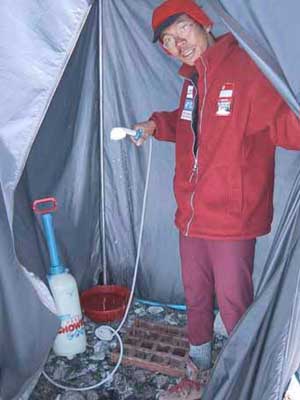
Beng Cheong in the shower tent, holding the portable shower set. The wooden plank on the ground prevent cold feet.
SHOWER AT EVEREST NORTH BASE CAMP (5,300M)
First of all, not everyone is ready for it, until…… a certain time is reached and a particular smell become unbearable to your friends. The final and the ultimate stage is reached when you’re pretty confirmed that you really require that wash up,… is when you can’t stand your own smell.
Secondly, you have to choose a particular day where the weather is definitely sunny for at least the first half of the day…. and you will have to take that shower at a particular time if you do not want to rush it. You may ask WHY? Well,.. the reason is simple! That particular time I’m talking about have to be around 10.30am to 2.00pm. Any time outside that range has NO Guarantee of warm (23 to 26 degree Celsius) atmospheric temperature that is ideal for taking shower at this harsh Tibetan plateau. Even inside the shelter of a tent fabric, the bone chilling wind from the Rongbuk glacier will be good enough reason to deter you from having your shower! We have for the past 60 days observe the good weather pattern happening at Rongbuk Basecamp. Even for the best day we ever had, those nasty clouds will soon start pulling in slowly after 2pm.
Thirdly, you have to inform the Basecamp cook early about the time you want your shower. They will need time boil your water and get ready the pump and the shower tent for you. Well, this time round I’m pretty lucky. A standing shower tent was pitched up only 2 days ago when a group of trekkers came in to visit the base camp. For the first time ever, I experienced potable hot water standing shower after more than 60 days at the Rongbuk base camp. Before the standing shower tent was installed, we have to make do with a sitting down low ceiling tent for washing up. Quite awkward !!
Finally, when everything is set,….. meaning, you got everything needed for the shower ( soap, shampoo, towel, hot water, etc). You will still require to have speedy actions, before, during and after shower. Because, your naked body haven’t been exposed to high altitude (5,300m) air for quite sometime. So,.. you will naturally feel the great different in temperature. Once your skin sense the cold. . . . your brain will automatically be informed and eventually instructions will be passed down, “Hey pal,.. better speed up your action, I’m getting cold !!”.
In conclusion, my advice is, unless you are really damn smelly, don’t do it too often!!! You need a hell lots of practice, to get it perfect!!!
Ting Sern
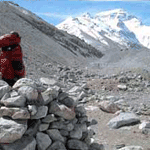
Facing Mt. Everest but open to winds. Brr… very very cold! |
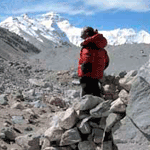
Facing Mt. Everest with a bit more shelter. Most popular!! |
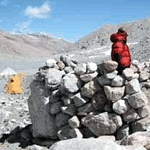
Facing Basecamp. Least smell. Has wide open space. |
As part of the “infrastructure” support at Everest Base Camp (Rongbuk), the loos are pretty primitive but they serve a vital function.
We have 3 of them, perched on a small outcrop of rocks that overlooked the Base Camp. They are sited about 20 meters away from the campsite (where we sleep). Because of the directions of the prevailing winds, no smell has ever reached our sleeping place.
They are constructed mainly of loose rocks that form a semi-circle (to protect the user from the extremely cold winds as well as to provide for some modesty). Our human waste, “the dump”, is left exposed to the elements which does a very efficient job at reducing it to a rock-hard like mess after being exposed for more than 24 hours. There is hardly any smell from “the dump” the following morning. If they overflowed (and they did twice so far), I will bring up kerosene along with a kitchen cook to burn the residue.
One of them faces the Basecamp and is the most “open” of them all. It is a pretty large semi-circle, thus the most unprotected of them all. However, it does mean that it is also the one with the least smell.
The other two faces Mt Everest. One of them is always overflowing – because it is probably the most sheltered of the three loos – and thus, presumably, the most popular. The other one, which faces the “south-north” wind, is not so popular because it is probably the coldest of them.
By the way,.. at the end of the expedition, all waste will be burn off and clean up before we leave base camp.
Ting Sern
Laundry at high places
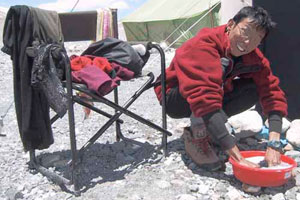
Everest North Base Camp (5,300m)
“Hey,.. Haven’t I seen you wearing this jacket for the whole of last week?”, someone’s yelled at you!
“Haven’t you got any other stuff to change?”, said an American friend at base camp.
Well, if your skin is particularly thick and can’t possibly be measured by a vernier calliper – then perhaps, you could get away from it ! The whole idea of having to wash your clothing is actually for your own cleanliness and hygiene. However, it seem like other people awareness of your daily or weekly attire simply take over the upper hand!! You might be quite lonely if you insist of not washing and changing your clothings.
Hey,.. the air at this altitude is so fresh that any amount of smell could be easily detected by the human nose if there is no strong wind blowing. Well, on many occasions, trekkers and climbers have to congregate at the well enclosed dinning tent for breakfast, lunch, and dinner. The distance that you are sitting beside each other is close enough to sense any strong smell that will deter conversation anyway!!!
After a whole lots of explanation above about the importance of “Laundry at Base Camp” , I suppose the task now is to do it !
Look for a sunny day to do this if you don’t want the prospect of having all your clothings turn into “Steel Rod” or ” Sheet metal”, meaning, frozen hard. Sometimes if the wind is strong enough and persistently blasting for the whole day… Well, he he he? The nasty wind will rob the sun energy away and your stuff will harden. So,.. be very careful to keep a watch out for the wind!!!!
Next, you gather all your smelly clothings (socks, underwear, fleeces, hats, etc) in a bag and enclosed please!! Ask the kitchen cook about an hour before to prepare for warm water,… and I really mean “WARM” water. If you can get the water hotter, so much the better.
Go to the shower tent or somewhere that has good shelter from the wind to do your laundry. Once you get started,… remember, the same thing like taking a shower. Be quick or else the water get freezing cold in such a fast time that will surprise you!! Fast action certainly helps you get away from having numb fingers!!
Lastly, remember to hang and tie off every single piece of clothing. You don’t want to go against the “Wind Of Everest”, having to chase after your stuff. Next, don’t forget to retrieve your stuff in time. Bending and hammering your stuff is no fun, especially if you don’t get sunny days for the next entire week. Well, WHO KNOWS,….. after all this is Everest Basecamp!!!
Beng Cheong
PS: Hey Mom, I’m finally doing my own washing!!!.
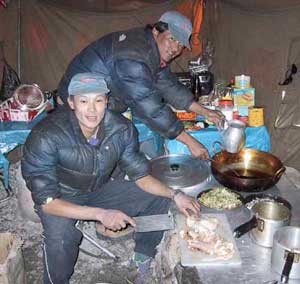
Without them, no expedition would survive that long in a desolate environment such as this Everest Base Camp (Tibet). They are responsible for dishing out the most mouth watering receipies in the harshest place on Earth.
Cooks that serve most mountaineering expeditions to the Himalaya (both Nepal and Tibet) are mostly Nepali. Very few expeditions use Chinese cooks (the reader is asked to figure out why). Most Western expeditions (this one is no exception) prefer to pay the CMA (Chinese Mountaineering Association) leevies to bring Nepali cooks across the border from Nepal into Tibet.
While most cooks are identical to those that work in Nepali restaurants and hotels, the “expedition cooks” must have the ability to work at high altitudes (4,000m and higher – this base camp is 5200m).
Expedition cooks work in conditions that might look appalling to most people – their tent (the kitchen tent) is dim, and the atmosphere is kerosene filled. They are all very hard working people too – a typical day schedule of an expedition cook looks something like this –
| Wake up at 5:30 am |
| Boil water and clean up the pots and pans for the day |
| Start preparing breakfast at 7:30 am |
| Breakfast is served at 8:00 am |
| Clean up after breakfast |
| Start preparing lunch at 10:30 am |
| Lunch is served at 12:00 pm |
| Clean up after lunch |
| Prepare pop-corns and tea at 3 pm |
| Serve tea and pop-corn at 3:30 pm to 4 pm |
| Start preparing dinner at 4:30 pm |
| Dinner is served at 6:30 pm |
| Clean up after Dinner |
| The kitchen is closed at 9 pm |
| The cooks goes to Zzzzz ! after that. |
Our cooks, Tara Bir Yakha and Pemba Tshiri Sherpa
However, the final results are often comparable to Kathmandu restaurant standards!! Excellent hygenic conditions are maintained in base camp kitchens – this author has yet to get a tummy upset after eating food prepared here for the past month or so.
Sometimes, their skills are simply unbelievable – they prepare and bake cakes without the use of an oven, they create receipies that are simply out of this world (for this environment). Perfectly roasted chicken drumsticks and excellent quality fried noddles are standard stuff here.
Yummmmie ….. my mouth is watering now 🙂 !!!
Ting Sern
Who says being a technical officer of an expedition is a “paid holiday” to somewhere exotic? Before you judge, think again ….
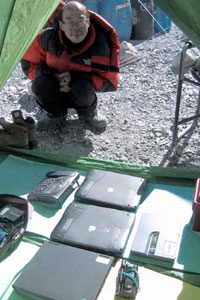
Baked Apples anyone???
My daily routine schedule is as follows –
a) Wake up at 7:45am (typically, earlier – but the temperature is too brrrrrrrrrr to even warm up my brain – so I maintain a very intimate relationship with my down jacket and sleeping bag until the sun warms up the interior of my tent to a nice and cosy 18 deg C).
b) Breakfast at 8:15am (the chief cook – a Sherpa himself, will bang on his frying pan with a frying handle long enough for the dead to be woken up. Incidentally, I wonder how long will his frying pan / handle last – but I think it should be long enough to serve us through the expedition or he must have lots of spares around)>
c) Work starts at 9am in the Comms tent.
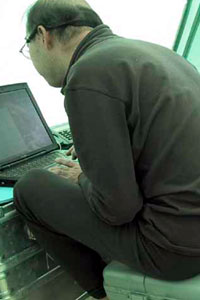 First, previous night’s snow must be cleared (if any) unless you prefer to work with an aqualung. The “king a la king” – our two solar panels are then taken out gently to be laid on the ground outside the comms tent. Actually, these solar panels are supposed to be military standards issue, but I think Pentagon didn’t think that mil-specs include being exposed to -30 deg C at night and 30 deg C during the day. We actually found two broken wires inside one solar panel and I had to “operate” on it to solder the broken wires together. Luckily, Humpty Dumpty has some capable “king men” to glue him back!
First, previous night’s snow must be cleared (if any) unless you prefer to work with an aqualung. The “king a la king” – our two solar panels are then taken out gently to be laid on the ground outside the comms tent. Actually, these solar panels are supposed to be military standards issue, but I think Pentagon didn’t think that mil-specs include being exposed to -30 deg C at night and 30 deg C during the day. We actually found two broken wires inside one solar panel and I had to “operate” on it to solder the broken wires together. Luckily, Humpty Dumpty has some capable “king men” to glue him back!
Baked Apples anyone???
Next, the computers and all the electronic hardware are taken out to be baked in the sun. This is necessary because the night here is very cold and condensation does form on printed boards. If one should attempt to power on the hardware in such a condition, that poor guy might receive a most disagreeable shock followed by a last grasp from the dying machine. Since we have only a limited supply of such machines, we have to avoid inflicting such final treatment to them.
We then verify that the solar panels and the power supply is okay before we start connecting the electronic hardware into them for charging their built-in batteries. Hold it …. we aren’t running a PUB power station here – we have only generating capability for 6 amps of 12 volts supply only – hardly enough to power a typical kitchen water kettle. That means we can’t just plug everything we want to charge into an “infinite” power socket that virtually everyone in Singapore has taken for granted. Here, we have to prioritise things and charge those that are vital for its immediate use.
A typical work schedule might be “email download and upload”. Everyone in Singapore is familiar with a telephone and its usage. In this wilderness, there is no phone line and to communicate with the rest of the world, we have to rely on a very exotic (and expensive) technology – satellites. So, the connections to the Internet means we have to connect to a communications satellite, many of them are really established for ships at sea. Inmarsat (International Maritime Satellite) is the most famous of them and we use them here too. We have to know where the satellite is located otherwise, we get NO connections.
After pointing the antenna to the relevant satellite, we power up the modem unit and plug its connector into the computer. Only then we can start sending and receiving emails. Because satellite connections are slow, we can only do emails at 2400 bps (most homes in Singapore can send emails at 56,000 bps and faster). Patience is a virtue here. Sending pictures (a 40Kbyte JPEG file) takes 5 to 10 minutes here. Sometimes, we experience line drops (nothing extraordinary with satellite communications). These can be caused by heavy clouds or snowfalls in the direction of the antenna. Sometimes, the reasons are unknown. Whatever the reasons, a line drop means we have to re-establish connections all over again – a waste of money as far as we are concerned. Cost of satellite time varies from US$0.80 to US$13.00 per minute depending on which device we use.
Personal emails, official reports and photographs (the ones that you see in the website) are the main items we transmit and receive daily. The really biggie ones (large JPEGS bound for newspapers and movies) are sent using another technique – utilising the Nera M4 World Communicator, which is capable of sending data at 64,000 bps (ISDN speeds). Digital photos have to processed by Adobe Photoshop before transmission – to keep its size down. Movies have to edited by Final Cut Pro and compressed using QuickTime before we can even talk of sending it back to Singapore by M4.
If you think this is fun, think again. The comms tent is unheated and we are at the mercy of the outside weather. Sometimes, it gets so hot during the day, I have to work in short sleeves and rolled up trousers. Then it can get so cold you reach for the down jacket – all within 5 minutes.
d) We normally break for lunch at about 12 noon which takes about 1 hour.
e) Work starts again at about 1pm and typically, continues until about 5pm (when the cold starts to make itself felt). It might end earlier if the weather decides otherwise. So, we are literally at the mercy of the elements …. something you don’t experience in Singapore (sheltered in your home).
f) We then packed up everything and locked them inside the aluminium trunk for the night. This is the only security we have – but then, we hardly have thiefs which can make use of all those electronic equipment we have.
g) Dinner time is normally 6:30pm.. After dinner, we head for our tents and “sweet dreams” after that – rest enough to start again the next day.
Anyone for a restful holiday here? You are welcomed to try ……..
Ting Sern
Ting Sern’s Life at Basecamp
Basecamp can be both boring and exciting, depending on events that happen here.
Firstly, what are my routine jobs (the boring ones)?
a) Set up the power supply unit for all the electronic equipment. Since all computers (Apple Powerbooks) and satellite communications equipment (Nera Worldphone & Ericsson R190 ACeS) depend on electrical power, this will the most important job for me. We generate electricity from solar energy (the cleanest, non polluting source) by using solar panels. The solar panels we use are a pair of UNISOLAR 30 watts foldable panels, capable of giving a minimum output of 30 watts at 12 volts. I have measured power output as high as 2.9 amps at 25.6 volts (thereby exceeding the manufacturer’s specifications). We can’t feed the power output from the solar panels directly into electronic equipment since the power will not be constant, but fluctuate – depending on the quality of the sunlight at any given instance. A solar “charge controller” (ProStar 30) is used to control the power of the solar panels, to charge a reserve bank of sealed lead acid batteries (SLAB), and to regulate the quality of the electrical output from the system. We use two 7AH (amp hour) SLABs and one 2.6 AH SLAB. The number of SLABs that we can carry depends on the total weight we are prepared to carry, since SLAB are not light. The ProStar 30 is capable of delivering 30 amps at 12Volts sustained – and this has been confirmed in tests conducted by me in Singapore.
b) Set up the computers for Satcoms (satellite communications) operations. This is rather technical – but I shall explain the basics here. We use 2 forms of SATCOMS here – one in fallback operations to the other. The system of choice (the cheaper system in terms of airtime) is the ACeS (Asian Cellular Satellite) system and the mode of delivery is the Ericsson R190 ACeS handphone. The ACeS system can only be used in ASIA but it can access worldwide phone numbers. Cost of airtime is about US$0.80 per minute. The backup system is the Inmarsat (International Maritime Satellite) system and the mode of delivery is the Nera Worldphone. The Inmarsat system is worldwide in reach. Cost of airtime (commercial rate) is US$3.00 per minute, although the expedition has secured substantial discount of airtime from SINGTEL (Singapore Telecoms) – it is still very expensive, compared with the rates charged by ACeS. Both systems are essentially for voice mode, although both of them also offers data mode (only 2400 bits per second) which is what the expedition is using for the bulk of data transmission to / from Base Camp. Even though the Inmarsat system is expensive compared to ACeS, it makes up for it for its reliability under adverse conditions which the ACeS system will fail. Also, at this present moment, we have encountered operational problems with ACeS system that makes fallback to Inmarsat system mandatory at times.
Both the systems are attached to the Apple Powerbook in its own distinct ways. The ACeS system is hooked up to the Powerbook via its own extension cable (from the handphone) and plugs into a PSION Gold Card modem (ISDN & Cellular capable), which goes into the Apple’s PCMCIA’s slot. On the other hand, the Nera Worldphone is hooked into the Apple Powerbook’s USB port via a XIRCOM serial to USB convertor. The Nera Worldphone has its own 9 pins serial port.
To maintain two separate systems and keep both of them functional demand skills not commonly found in most people!
Because the satellite links are so slow (2400 bps – compared with 56,000 bps found in most homes in Singapore, and for the lucky few – 512,000 bps or even faster with CABLE or ADSL links), we have to restrict the kind of output we can receive and send. Anything that takes longer than 10 minutes to send per item is a definite NO NO.

The Nera Worldphone is hooked into the Apple Powerbook’s USB port via a XIRCOM serial to USB convertor. The Nera Worldphone has its own 9 pins serial port.
c) Maintain the hardware and software in good running order. We are operating at 5,200m, an altitude that is way above any manufacturer’s limits. 99% of all commercially obtained hardware limits the operating altitude to 10,000 feet or 2,500m. All the hardware we use at Base Camp is at least twice the height of the limits imposed by manufacturers. Also, the environment here is very dry and dusty. It is a tribute to the various manufacturers that the equipment we use here can work at all!
Even then, hardware will eventually fail if used in prolonged conditions that are prevalent in Base Camp. To prepare for that eventuality, we bring hardware diagnostic equipment (Fluke Digital Multimeters and Scopemeter) plus a complete set of electrical and electronic repair tools up here. Apple Singapore has also kindly supplied the expedition with 2 complete sets of spare parts for the Apple Powerbooks that we use here. I have also been trained to strip the Powerbook and replace every component that it uses. In fact, a hard-disk used by the Powerbook has been replaced in the field when it failed about 2 weeks ago.
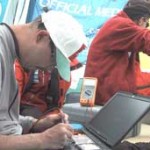 For those non user replaceable items, we bring two units if the item is essential to the operations.
For those non user replaceable items, we bring two units if the item is essential to the operations.
This of course implies the person doing this has to understand basic electrical and electronical parts, be able to diagnose and repair hardware faults in the field.
d) Write field reports (the ones that get sent to our folks back home) and send them back to Singapore via Satcoms links. Sometimes, the climbers are very far away (20km) from Base Camp and the only way to contact them is via walkie talkies. Unfortunately, our Motorola walkie talkies are out of range when attempting to bridge a gap 20km long. Under such circumstances, I have to wait till available information from 3rd parties become available or wait for the climbers to return before I can file the reports.
Those tasks represent the bulk of my daily routines.
Then there are the exciting ones, which happens once in a blue moon ….
Our solar charge controller refused to work about 1 week ago. Without a functional solar charge controller, I will be out of electrical power (an equivalent of a black out). I was in panic mode – it took me 20 minutes to diagnose the fault and 10 minutes to fix. Whew, what a relief when I got it working again.
Twice, I have been consulted by another expedition on their PC hardware faults – and had to replace one of their PC notebook’s harddisk (A DELL) using spares that was carried up by their trekking parties.
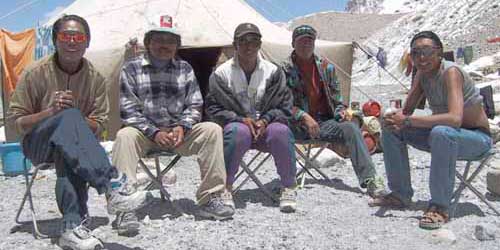
From Left : Pembageljgen Sherpa, M.B. Tamang, Kami Tshiring Sherpa, Danuru Sherpa and Mingmawange Sherpa
Sherpas have been described as the workhorse of any modern Western Himalayan mountaineering expedition. A better tribute to them will be this statement “No Western team will be able to climb Mt Everest without the assistance of Sherpas”. Even Sir Edmund Hilary climbed with a Sherpa too – Tenzing Norgay.
However, there are some Western expeditions who climbs without sherpas assistance – but it is a lot harder on them.
Sherpas are of Tibetian origin, and nearly all of them are devout Buddhists. They made their way to present day Nepal about 20,000 years ago. Nearly all “mountain grade” sherpas come from the area around Namche Bazar – the sherpa capital of Nepal (and of the world). The area is about 4,000m above sea level and is the headway into Mt Everest National Park (Nepal side).
Physically, the sherpas are short people (most of them are about 5 feet to 5 feet 6 inches), have extremely strong leg and back muscles. This characteristics allow them to carry heavy weights over mountainous terrain. I have actually witnessed a sherpa carry down an injured Western climber well over twice the sherpa’s size and weight from Jannu (Kangchenjunga region).
They also have a “medical mystery” – which allows them to ascend to great heights without ill-effects (acute mountain sickness – AMS). A study conducted by a Western team of researchers based in Labuche (Everest region) some years ago showed that there is “no medically identifiable element in Sherpas that could explain why they are not suspectible to AMS”. But, it is an undisputable fact that sherpas are the only people who could carry 30 kg, ascend from 6,200m (Camp 2 (ABC) – Nepal side) to South Col (7,900m),? dump their loads there, and descend to ABC within a single day. Within a course of a normal expedition, they will head this way at least 10 times or more. Most Western teams could only do that trip in 2 days or more!
Sherpas are also very hard working people – on big mountains like Mt Everest, they are the workhorse, ferrying loads from lower to higher camps, assisting climbers of lesser abilities, and taking on chores that most people would find it very exhausting (due to high altitudes). They are also very humble people – despite their well known ability to excel at great heights (a Nepali sherpa holds the world’s record in climbing Mt Everest), they don’t boast of their ability generally.
Although some Sherpas have technical climbing skills equal to that of a modern Western climber – they still believe in their religious teachings. However, most of them don’t have proper technical climbing training – and rely on their great strength and stamina to overcome obstacles. Because of their Buddhist beliefs, a “Punja” ceremony is of great importance to them (they believe they have to please their mountain Gods before climbing it). Usually, a head of the nearby monastery will be invited to head this ceremony. Chantings and other relevant sayings would be made before a “punja” pole. Even technical climbing equipment will be blessed too. Finally, a rice ‘feast’ terminates this mandatory ceremony before a climb can proceed.
Ting Sern
Sharing a Basecamp
Q-The contact / communication / camaraderie among the other teams/countries
in Basecamp. Do you share stuff like equipment; talk about their countries
etc?
A- Our Basecamp does not belong to us actually. We are part of Eric Simonson’s climbing group (to save us money). This group is known as IMG (International Mountain Guides) and their job is to guide clients up “big” mountains. Most of the IMG people are from USA. Their clients are worldwide – so earlier on, we meet some people from France, UK and other countries. Every breakfast, lunch and dinner, we meet in the dining tent where all sort of topics are discussed. Some of the discussions are technical – mainly related to climbing of course, but sometimes, big items (like the US – China plane crash) are discussed too.
Technical climbing equipment are not shared (strongly recommended not to), but sometimes, when the other team runs out of critical supplies (like batteries), we will pass them some (provided we still maintain stocks ourselves).
We don’t have provisions for a big Basecamp BBQ – but yesterday evening, there was a big party in the main tent which is similar in nature to a BBQ was held there.
Basecamp
This is situated at the head of the East Rongbuk Glacier and 21km from Everest. Still, the enormous 3km north face of Everest dominates the skyline. Unlike from the south where most views are of only part of the mountain, here, you can get to see an almost unbroken view of the mountain. Famous features such as the Great Couloir, the Hornbein Couloir etc are all here. Essentially, what you have is a series of ice/snow gullies crisscrossing the monstrously large north face. Head on, it looks vertical but actually lies at a more gentle angle of about 50 degrees although certain rock bands do make the north side very precipitous. Occasionally, a flock of choughs (crow-like birds) will sweep past Basecamp. They can fly up to 9,000m!
At 5,400m, BC is a cold, dusty and windy place. A cacophony of morning coughing is common as are subzero temps once the sun goes down. Basically, except for when the wind isn’t blowing, its’ like living in a fridge (or a freezer). As May approaches, it is getting warmer but not very much so.
Life here is a routine of meals, resting between, writing emails, tending to minor repairs and so on. We power our laptops and other electronics with solar cells. The extremes at which our Apples and Canon equipment function is amazing – way beyond the manufacturers’ specs.
Meals prepared by our excellent sherpa staffed kitchen means meals comprise a combination (depending on the day) rice/oat porridge, pratas, chappattis, dhalbhat (rice and lentil soup), canned meats, occasional fresh meat and veggies. We supplement this with some Singapore goodies like fermented chilli tofu, ikan bilis, ‘bak kwa’ and so on. Some people can lose a lot of weight when climbing Everest, so the key thing when at basecamp is to try to recuperate, recover from infections, eat well, rest and plan the next move up the mountain. Right now, everyone is on antibiotics except for me, with the most common compliant being upper respiratory tract infections. I can’t describe how hard it is to sleep , breathe and climb when you are bunged up with streaming head colds and with snot of every colour emanating from your mucous membranes.
Three major differences between this expedition and the 1st one in 1998 are:
1. We’re climbing a much harder route.
2. This is a much smaller, international team and thus avoids much of the big team problems, diversity of opinions, egos and so on.
3. We’re working closely with an American team so the dynamics of this expedition are different from 1998 where we had a fully independent team. The Americans, led my my old friend Eric Simonson are on a search to find more evidence relating to the famous 1924 climb which may have placed climbers on the summit. The discovery of an elusive camera from that climb might prove conclusively one way or another what really happened. We’re just here to climb the mountain instead!
A few of the sherpas at basecamp are some old friends from past expeditions so it’s nice to see Kami Rita and Man Bahadur once more. If all goes well, we will be climbing with them again to the summit.
Life Above Basecamp
Here’s where the work begins. To even come to grips with the mountain, you have to trek to advance basecamp, 21 km away. This very long trudge and it is largely above 6,000m in altitude. This is very hard work and covers rugged terrain throughout. We normally spend 2 days to cover this distance.
At Advance Basecamp (ABC) you get to see the North Col, a snowy saddle (Col is an old Welsh word for pass/saddle) at 7,000m. This saddle forms the ridge that drops perpendicularly northwards from Everest’s Northface. To get to the summit, most summit attempts will place 2 more camps above the North Col before the summit. This gets us within striking distance (that is within one long day) to the top camp.
Living here gets much harder because of the cold and lack of oxygen. Worse is the constant wind that sweeps across the Northface, hammering anything (read: camps/climbers onthe north ridge) with its full force. Temperature, including the wind chill factor can drop to -25 at the Col. Food cooked has to take into account the limited resources to melt snow into water and thus comprises of various energey drink mixes, Brands Essence of Chicken, freeze dried meats and staple carbohydrates.
Regards
Dave
Last despatch from Nepal…
Dear Folks,
We’ve heard the shocking news today that most of the Nepalese royal family, maybe 9 or 11 members have been shot and killed by the Nepal Crown Prince. Today, virtually all the shops and offices are closed as both a mark of respect to the dead King, as well as fear of instability within the capital. Everything is calm here but it is a bit tense. We hope we can leave for our flight tomorrow morning without a hitch. Singapore Airlines, our Official Airline has kindly worked out some nice advance checkin for ourselves and our 40+ pieces of baggage.
Today, we also said goodbye to our American team and friends. In the two months on the mountain, we’ve seen a lot and learned a lot from these professionals. So it’s goodbye to our old and new friends.
From email, media reports et al, we’re happy to learn that the vast majority of Singaporeans and international watchers have been tremendously supportive – even if we did not make the summit. Technical and altitude mountaineering in Singapore is a sport less than 15 years old and combined international expeditions such as ours even less so. We need to mature, as do our supportive (or not so supportive) public. We need to be able to tolerate the need to achieve a bit more than just the summit.
The only fly in the soup, we understand, is a piece of inaccurate, biased and vindictive journalism published last week in the Today, a recently established Singapore newspaper. You just can’t keep everyone happy, so it seems.
We’ll probably do another final roundup of the expedition in a week or so. Also, we may add the 1997 Cho Oyu and 1998 1st Singapore Everest Expedition archives into the site eventually. We’ll also use this website to feature other expeditions by the Mountaineering Society of Singapore – so stay tuned. It was great to get all your emails, funny comments, words of encouragement. We’re going home soon to enjoy the , kisses and warmth of our loved ones and friends, the tropical air of Singapore, things more familiar, the stupendously good food at home.
From Gil, Beng Cheong, Rozani, TingSern and myself, a warm goodbye – until the next expedition!
Regards,
David
On the road…
Hi everyone,
This is WTS here, keying the last despatch (not the trip report) of this expedition. I am typing from my hotel room in Zhangmu – near the border between Tibet and Nepal.
The Nera M4 antenna is aimed at the IOR (Indian Ocean Region) Inmarsat satellite with barely enough signal strength to transmit data … but it works!
Okay …
These are the last two reports I promise ….
Q- What clothings do climbers wear?
A- Virtually all climbers today follow the layering system. Basically, it consists of 3 layers – the outer shell, the middle layer, and a innermost layer. Let’s start with the outer shell.
Depending on the nature of the climb and the expected weather conditions, the outer shell can be a down jacket (for warmth and windproofness) or a totally waterproof and breathable one (mainly Goretex materials). In most 8000m peaks, virtually all climbers will choose a down jacket, as the weather is mostly cold,but not wet. For tropical areas, a Goretex shell to protect climbers from the rain will be used.
The middle layer is mostly made of “Polartec” fabric – a material designed to keep a person warm but does not absorb water. Natural materials such as wool are excellent warmth keeping layer – but once it is wet, it hardly insulates well. Artificial materials such as Polartec are made from polyester yarn, and hardly absorb water. Hence, they will keep you warm even though it may be wet. This is important because as a climber exercise, perspiration will work its way into the middle warmth layer and soak it.
The inner layer is a wicking layer – mainly designed to spread the perspiration next to the skin and sent to the middle layer in a larger area. The idea behind the wicking layer is that if you increase the area to be exposed for evaporation, the perspiration will go much faster. Hence, the wicking layer is designed to absorb perspiration and spread it over a larger area.
Other clothings are worn – depending on the nature of the climb – such as if heavy snow is expected, then gaiters are worn over the shoes to prevent snow from entering the mouth of the shoes.
Q- How big are our tents
A- In base camp, we use a “two man” tent for personal use. This ensures that we have enough space to sleep as well as to store personal things inside the tent for easy access. Most tents at base camp are two walled tents – an inner wall which allows water vapour to escape easily (but is not waterproof) and an outer wall that is totally waterproof.
At higher altitudes, where weight is a premium, we will squeeze two people and their stuff into one “two man tent”.
If weight is really an extreme consideration (as it will be for summit attempts), a single walled tent is used. This material is similar to Goretex (which is waterproof, but also allows water vapour to escape).
Ting Sern
Going home
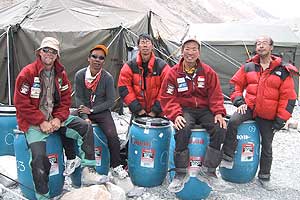
From left, Gil, Roz, Beng Cheong, David and Ting Sern. A bit worn but happy.
Dear Folks,
200 yaks are headed up to ABC yesterday – most of the expeditions are tidying up and wrapping up their businesses and the yaks will be bringing down equipment, rubbish, summit and high camp gear. Over here, packing to go with the impending monsoon, rains, snow and so on. Last night we had a small get together with the RAF Mountain Rescue Team who are also here climbing Everest. The single malt whisky was most welcome 🙂
It’s been a heck of a trip, even if the summit was not on the cards. Our return journey will take us back to Tingri (4,300m), and then Zhangmu (2,200m) where we hope to survive the hot dusty plains after Kodari back to Kathamandu. There’s a 3-day general strike starting today in the capital. We’ll be posting 1 -2 more reports from Kathmandu but until then, it’s been great having all your supportive email, comments and questions.
If you’ve enjoyed the ride so far, do help the Society for the Physically Disabled by going to http://www.brandsworld.com and registering your support. One of our key supporters, Brands Essence of Chicken will donate $1 for every support registration received. Many thanks!
Ciao,
David
The Party’s over
You’ll get a chance to read Gil’s account of the summit push (translated to English>>> go to Gil’s report) .
Some really interesting news is the summit success of blind climber Eric Weihenmeyer ( sic ) from the south side. My old friend PV Scaturro was one of the sighted climbers assisting this remarkable man who makes even the hardest tasks seem easy after his ascent. Eric has made previous climbs on Aconcagua, Denali and Vinson . Way to go!
The French paraglider tandem couple Bertrand and Claire have also confirmed that their recent, spectacular jump from the summit is a record. In 1990, when Bertrand was only 17 years old, he summitted Everest with his father and then they both paraglided from the South Col ( 8000m ) to basecamp. The recent successful jump makes it the highest ever from a mountaintop.
The party’s over now on the summit. Today, grey clouds, high winds and predicted snowfall makes it clear the superb summit window we’ve seen these past few days is closed. We’re counting down the days before we leave.
Ciao,
David
Real Everest Heroes
Dear Friends,
We’re wrapping up the expedition soon. We’ll have a final report when we get to Kathmandu but until then will keep on transmitting until we have to pack to leave on the 28th.
Yesterday, members (all professional guides) of the IMG 8000/Mallory + Irvine Research Expedition 2001 abandoned their summit bid to save the lives of stricken climbers on the summit ridge. While we have had an informal arrangement not to report on the movements or activities of the Eric Simonson-led expedition owing to some exclusive news arrangements, the gallantry of the American team for their deeds on the 24th deserves a special mention in today’s report. Information is a bit sketchy in places and we’d be happy to make suitable changes to the story if corrected.
Beginning early in the morning, the team of Andy Politz, Dave Hahn, Jason Tanguay, Tap Richards, Phu Nuru and Phu Dorje began a swift ascent of the standard summit route when three Russian climbers were found huddled near Mushroom Rock (between the First and Second Steps) — in pretty bad shape after having spent a night out after their summit bid. Oxygen was given, modifications made to their oxygen kit so a switch could be made to the American oxygen tanks. High altitude medicines were administered and the team stayed until the Russians had revived sufficiently to get moving downhill. A couple of hours later, two members of Russell Brice’s team were discovered near the bottom of the 3rd Step. Guide Andy Lapkass and a client had also spent a night out. It is uncertain if Andy Lapkass had decided to stay with his client to help him through the harsh night or was himself exhausted from the summit bid. In any case, both were suffering from vision problems (most likely caused by cerebral edema), frostbite and unable to move. Again, medicines and oxygen were administered. The sherpas attached to the IMG 8000 team gave up their oxygen gear for these climbers and descended. Shortly after, the summit bid was called off so that these two stricken climbers could be escorted down to safety by the team.
The slow and extremely taxing affair took all day (a beautiful summit day with many summtting from both sides). Russell Brice sent up a team of sherpas with extra oxygen to Camp 6 where his other guide, Chris Warner had spent the night in relative warmth and safety after successfully tagging the summit and returning. The rest of the Russian team were not involved in the rescue.
It is not known if Warner made any significant attempt to assist in the rescue after the arrival of his team’s sherpas. It is known however that several of Russell’s sherpas did make a move up the ridge with extra oxygen in the rescue. Russell Brice has been involved himself in coordinating numerous rescues in the past ten years so it seems the deposits of good karma that have been made paid off yesterday when it was his team’s turn to need help from others. Later in the afternoon, the team came across the same Russians they had helped earlier in the day, still struggling down. More assistance was rendered but one Russian was beyond help and died. The Americans were becoming almost like a extreme altitude paramedic squad.
In an unrelated situation, another climber died in high camp from yet to be confirmed causes. Our sympathies to all the friends and families of the lost climbers.
All the injured climbers still have to make their way down to the North Col and then the long, 21km trek back to basecamp. But it appears they are out of mortal danger now.
It must also be added that on the north side, several teams passed by both teams of these stricken climbers on May 24th without rendering or offering any major help to them. It seems ” summit first ” is the motto of many on Everest.
Including the Chinese glaciologist last month (he is now reported to be alive and recovering), these rescues by the Simonson team have saved at least FIVE lives on Everest this season. In both cases, team members had given up summit chances to render assistance.
I personally wonder how many summitters from the north side on May 24th will go home with a little twinge of guilt for not helping. But being called an ” Everest hero” by the undiscriminating media and friends for the rest of their lives must certainly help assuage the guilt……..
In the meantime, you can send your good wishes to some ‘real’ Everest heroes on http://www.mountainguides.com (The Mallory + Irvine Research Expedition 2001 site).
Way to go, guys.
Dave Lim
at East Rongbuk Base Camp